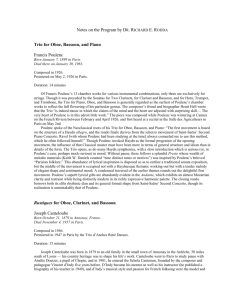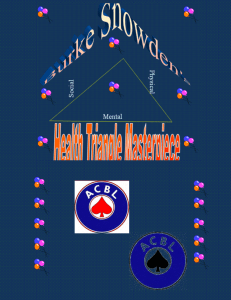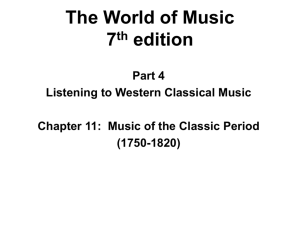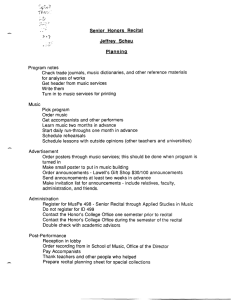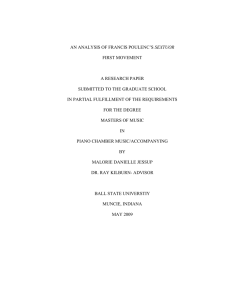A LOOK AT MID-TWENTIETH CENTURY OBOE COMPOSITION POULENC
advertisement
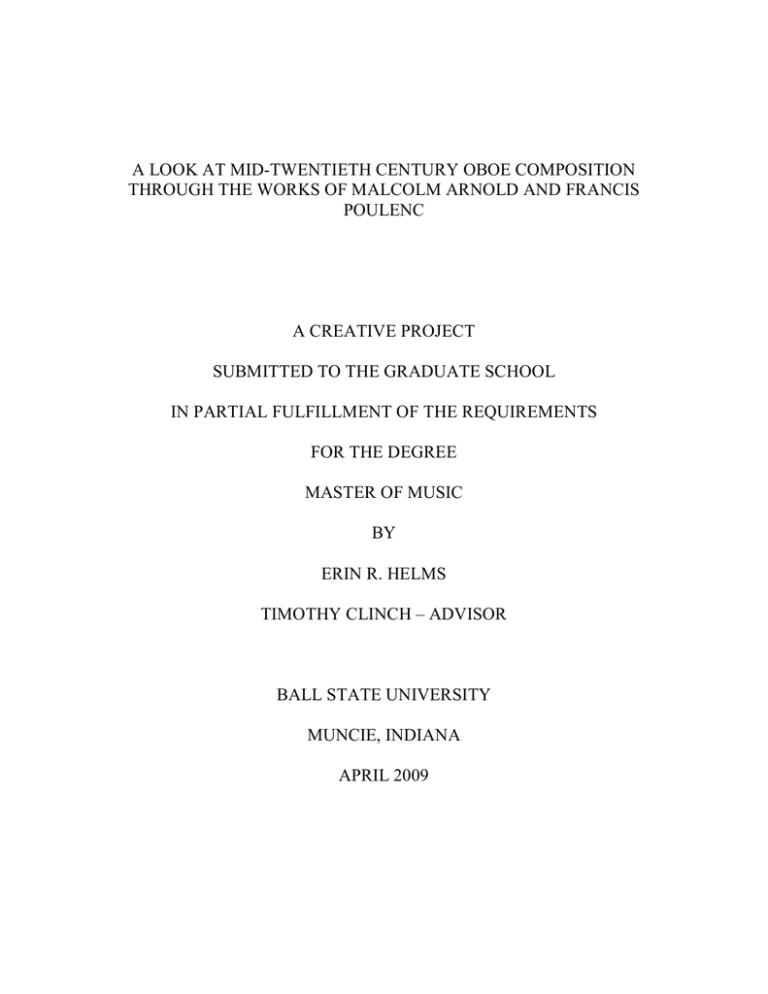
A LOOK AT MID-TWENTIETH CENTURY OBOE COMPOSITION THROUGH THE WORKS OF MALCOLM ARNOLD AND FRANCIS POULENC A CREATIVE PROJECT SUBMITTED TO THE GRADUATE SCHOOL IN PARTIAL FULFILLMENT OF THE REQUIREMENTS FOR THE DEGREE MASTER OF MUSIC BY ERIN R. HELMS TIMOTHY CLINCH – ADVISOR BALL STATE UNIVERSITY MUNCIE, INDIANA APRIL 2009 Introduction For the many years that the oboe has existed as a solo instrument, composers have used styles and compositional techniques to highlight it stunningly. While the baroque period emphasized brilliant virtuosic writing, the classical period brought forth a genre of simple and refreshing melodies that helped to push form into the forefront. The romantic period provided another contrast as composers sought to feature longer melodies, undefined by the strict formal structures of the classical period. Composers in the twentieth century continued the gorgeous use of the oboe as seen in the works for oboe and piano by Malcolm Arnold and Francis Poulenc. Written in consecutive decades, both the Arnold Sonatina for Oboe and Piano and the Poulenc Sonata for Oboe and Piano use pleasing and individual techniques in their scoring. Arnold history Malcolm Arnold was born on October 21, 1921 in Northampton, England to William and Annie Arnold. His musical talents were apparent from a young age and he began to study the violin at age four and the piano a year later. From age six to eleven he attended a small private school close to his home in Northampton called Eaglehurst College. As he was often ill as an asthmatic, he did not complete his formal schooling for fear of mockery from the other children and was allowed to stay home. Although trained in piano from a young age, Arnold would eventually choose another instrument: the trumpet.1 1 Paul R. W. Jackson, The Life and Music of Sir Malcolm Arnold: The Brilliant and the Dark (Burlington, Vermont: Ashgate Publishing Company, 2003), 1-3. 1 Because of the wide gap of ages among the children in his family, the group as a whole seldom were able to be all together at once. When the occasion did arise however, one of their favorite pastimes was to listen to jazz. Arnold was captivated by the recordings; with his immense talents he could sit down and transcribe solos without the use of piano and play them immediately on the trumpet. Highly inspired by Louis Armstrong, the young Malcolm demanded a trumpet and lessons after an improbable meeting with his idol.2 After taking lessons locally for a few years, Arnold received a scholarship to study trumpet with Ernest Hall at the Royal College of Music. While there he also took lessons in composition, for a short time with Patrick Hadley and then with Gordon Jacob. As World War II diminished the ranks of professional orchestras, Arnold’s reputation as a great trumpeter won him the opportunity to play even before his graduation.3 In 1948 Arnold was informed by the Royal of College of Music that he was to receive the Mendelssohn Scholarship. This award granted a sizeable financial prize that enabled the recipient to further their musical education through travel. In the same year, Arnold began a trio of little sonatas, or sonatinas, written for his renowned colleagues. The first was written for flutist Richard Adeney on (1948), followed by the oboe sonatina for Leon Goossens (1951), and finally the clarinet sonatina for Frederick Thurston (1951). Arnold tried to make each of these capture the essence of the person it was dedicated to, while showing off the capacity of the instrument.4 2 Paul R. W. Jackson, The Life and Music of Sir Malcolm Arnold: The Brilliant and the Dark (Burlington, Vermont: Ashgate Publishing Company, 2003), 4-5. 3 Piers Burton-Page, “Sir Malcolm Arnold” in Grove Music Online. 4 Paul R. W. Jackson, The Life and Music of Sir Malcolm Arnold: The Brilliant and the Dark (Burlington, Vermont: Ashgate Publishing Company, 2003), 31. 2 The Arnold Sonatina The sonatina begins with a swift movement marked Leggiero starting with a repeated shifting figure in the piano. Throughout this first section the left hand is alternating between F major and E flat major triads while the right hand consistently plays syncopated B flats. This technique creates a feeling of sound colors with oboe line being a separate entity. The melody in the oboe begins with a line that displays Arnold’s use of chromaticism. Not only does he incorporate it into the solo line, but also by using chromatic shifts from phrase to phrase moving between E flat major to E major. The flighty E flat line in the oboe carries into a chromatic shift at rehearsal A. The melody in the oboe continues in E major while the piano left hand changes to alternate between F major and E major triads with the syncopated B flat moving up to a B natural in this four measure phrase. The line then shifts back to E flat concluding before rehearsal C at pp. Arnold continues using this melodic content, this time growing in volume, up to a new thematic idea at rehearsal D. The music between rehearsal D and F shows Arnold’s ability to write virtuosic lines for the oboe as seen in figure 1. Figure 1. Malcolm Arnold Sonatina for Oboe and Piano movement I - page 4. 3 In the third measure of D he introduces a two measure quickly articulated motive which at the tempo marking indicated would force most oboists to double-tongue. Arnold follows this with a technically difficult measure before moving the melody to the piano while the oboe provides staccato accompaniment. This section shows Arnold’s continued usage of chromaticism, this time both in the oboe and piano lines. The transition into rehearsal F highlights another method Arnold liked to use: the juxtaposition of opposites. In the measure before rehearsal F, the oboe is still playing its staccato eighth note accompanimental line while the piano has the final iteration of the quickly articulated chromatic motive. This moves without indication into greatly contrasting lyrical writing. The next section from rehearsal F to N consists of two lyrical sections encompassing a lighter more staccato section. The lyrical sections allow the performer to show off their legato and ability to play large leaps. During these flowing passages Arnold creates rhythmic instability by coinciding the expected duple eighth notes in the piano with unlikely occurrences of triplets and quintuplets in the oboe line. The first part of the middle section reveals Arnold’s quirky style with a passage of eighth notes, each preceded by a grace note a half step lower. He then moves on to again show the range of the instrument by employing octave leaps through the registers. Arnold returns to the lyrical section, this time written a whole step higher, which concludes at rehearsal N. The main theme now comes back with the same principles of decreasing dynamic level and harmonic immobility, and Arnold ends the movement on an E flat. The second movement, marked Andante con moto, is structured with the alternation of two theme groups. Arnold again uses the harmonically static chord shifts 4 to create sound colors. The first theme is an espressivo line in the oboe which revolves around E flat. This line extends over the alternating triads in the piano. Every statement of the phrase grows in expressiveness as Arnold adds more notes each time going into the first E flat. Throughout this movement Arnold also continues to use chromaticism, especially exploited in the ornamental figures at rehearsal A. The next theme involves more dialogue between the oboe and piano beginning with an ascending motive which descends to give way to the canonic entrance of the theme in the piano. He alternates between the themes two more times ending with the second theme, this time accompanied with the same material as the first theme. “Although they are called little sonatas they are far from easy to play – indeed the Oboe Sonatina requires a high degree of virtuosity.”5 The truth of this statement is no better shown than in the final Vivace movement. It begins with three declamatory eighth notes in the piano followed by the main horn-call theme in the oboe. With continuous rhythmic patterns and scalar runs, this section begins to show off the technical capabilities of the performer through long flowing, yet quick, lines. Throughout this main theme section the oboe remains continuous; however, the piano comes in at sporadic places repeating its pompous motive and eventually using it to drive into the second theme. This section highlights the non-lyrical strengths of the instrument in addition to the rhythmic abilities of the oboist to not only play their line, but to also line up with the piano. In this theme group Arnold asks for very short eighth notes with successive leaps and ties confusing the rhythmic integrity of the music. Arnold brings 5 Paul R. W. Jackson, The Life and Music of Sir Malcolm Arnold: The Brilliant and the Dark (Burlington, Vermont: Ashgate Publishing Company, 2003), 31. 5 back the main theme section from Rehearsal C to E, this time changing the initial arrogant piano quip to a longer sustained version of that same motive creating a rhythmic hemiola. While the oboe remains in a compound meter with two beats per measure, Arnold expands the piano motive from three eighth notes to three dotted quarter notes thus creating a three versus two metrical feeling. Figure 2. Malcolm Arnold Sonatina for Oboe and Piano movement III - page 14. The short section at rehearsal E is the pinnacle of technical virtuosity in this piece. In involves the alternation of extremely fast scales in the oboe with rhythmically ambiguous figures in the piano. As seen above in figure 2, the B major scalar runs are not only extremely fast (as the tempo is marked at 152 beats per minute), but also extend through a large portion of the range. At rehearsal F there is an immediate reiteration of the second theme which moves directly into the restatement of the first theme at rehearsal G. This section is embellished by extra grace notes in the melody and a new ending which culminates with repeated eighth notes on high C, D, and E flat. This line then carries downward in arpeggios to a low B flat which then cadences on an E flat. 6 Throughout this piece Arnold uses several unique compositional techniques to highlight the oboe. His first movement themes utilized chromaticism, sound colors, concurrence of opposites, and rhythmic ambiguity. The contrasting second movement really emphasizes the sound color technique first introduced in the first movement while also incorporating a great deal of chromaticism in the oboe line. The third movement shows Arnold’s technique for effective virtuosic writing. Like the first movement, he metrically complicates things with either syncopated entrances or the combination of two different meters. This serves to add to the forward moving impatient feeling of this movement. Using these techniques, Arnold presented the oboe in a new and interesting light. Difficulties in Arnold Throughout this piece there are several technical aspects that trouble the oboist. The first problem is the short amount of time to take breaths. Although the first movement is not very long time-wise, it is taxing, and one must be very efficient with breaths to make it through. The next challenge is the fast articulations after rehearsal D. While completely possible, it is not easy to double-tongue on an oboe as the reed being in the mouth creates difficulty for the tongue to move. The second movement provides struggles with tone color. The hazy nonfunctional harmony creates a mood that the oboe must try to fit into while trying to stay incredibly soft. The other difficulty in this movement is starting and articulating notes in a smooth way. While not easy, the success of this determines the mood and outcome of this movement. 7 The third movement provides the most apparent difficulties of the piece. Rhythm and articulation at rehearsal B provide a large challenge to the performer. With the syncopated entrances and ties, Arnold has made it difficult to have a true sense of time in this section. The articulation is also troublesome in getting the right amount of staccato to show the character, while maintaining the intended speed. Finally, the technical scalar passages throughout the movement are quite tricky. While they are just scales, these runs progress very rapidly through the registers of the instrument and require an enormous amount of practice to get up to speed and to stay in time. While some of the techniques required to play the Sonatina are not idiomatic for the oboe, they do capture Arnold’s end result. He incorporated the oboe in unique ways. While short, this piece contains several challenges which are well worth the virtuosic result. Poulenc history Francis Poulenc was born on the 7th of January 1899 in the center of Paris. His father Emile and his family came from Aveyron, while his mother Jenny was strictly of Parisian descent. Poulenc attributed his musical style to his very two sided lineage of devoted Catholicism from the Aveyronais side and artistry coming from his Parisian half. 6 As a young child, music permeated his home setting as his father never missed a concert at the Opéra and his mother was a rather fine pianist. From his earliest memories Poulenc felt driven towards music. By the age of two Poulenc already had his first small piano, although he hoped his calling would be singing. He failed to achieve this dream, 6 Myriam Chiménes and Roger Nichols, “Francis Poulenc” in Grove Music Online. 8 because, in his words, “when my voice broke I was left with the composer’s typical sorry squawk.”7 Poulenc began formal piano training at the age of five under his mother Jenny. By the time he was eight years old, he began to study with Boutet de Monvel, who was the niece of César Franck. In 1915 when Poulenc was 16 years of age, he met the great pianist Ricardo Viñes who identified his talents and began teaching him not only piano, but theory, composition, and music literature as well. Later in life, Poulenc recognized this as a milestone in his musical life stating, “That meeting with Viñes was a turning point in my life : I owe him everything…it’s really to Viñes that I owe my first flights in music and everything I know about the piano.”8 Although both his mother and father were avid music lovers and accepted Poulenc’s talents, his industrialist father wanted him to complete normal schooling instead of entering the Conservatoire. Attending the finest Catholic schools in Paris, Poulenc passed his exams and graduated, but it is clear he felt his musical training was not as consistent as he would have liked. 9 It was only in 1921 after his service in the army that Poulenc began to intensely study composition. Seeing that it was too late for him to enter the Conservatoire after being discharged from the army, Darius Milhaud suggested that Poulenc study with Charles Koechlin. His study began in 1921, in the same year that he had his first meeting with Prokofiev. Poulenc and Prokofiev 7 Francis Poulenc, My Friends and Myself, assembled by Stéphane Audel, tr. James Harding (London: Dobson Books Ltd, 1978), 33. 8 Francis Poulenc, My Friends and Myself, assembled by Stéphane Audel, tr. James Harding (London: Dobson Books Ltd, 1978), 36. 9 Francis Poulenc, My Friends and Myself, assembled by Stéphane Audel, tr. James Harding (London: Dobson Books Ltd, 1978), 34. 9 As the Sonata for Oboe and Piano is dedicated to the memory of Sergei Prokofiev, it is important to understand their relationship. In 1921, the Théâtre Sarah Bernhardt showed the Russian Ballet performing Prokofiev’s Chout. Coinciding with this performance was a luncheon where Poulenc was first introduced to Prokofiev. Poulenc felt their relationship was due to two connections: that each had a fondness for the piano, and that both loved to play bridge. During their time together, playing music was secondary, as their love of bridge was the initiating factor for their meetings. Aside from their love of piano and bridge, Poulenc and Prokofiev were two very different people. Poulenc sought to know his Parisian colleagues in the arts and was at least acquainted with the fellow musicians, artists, and poets around him. Prokofiev was aware of their existence, but was not often inspired by many other media. Poulenc acknowledged that Prokofiev did not care for his compositions and Poulenc went as far as to say that he felt Prokofiev was not an innovator. While he certainly thought that he was an exceptional composer and pianist, Poulenc did not feel that music as a whole changed resulting from Prokofiev’s compositions. As an outcome we see that their friendship did not appear to be a deeply musical one, but one of common interests with music often involved as additional entertainment.10 The Poulenc Sonata The sonata, finished in 1962, was the last piece written before Poulenc’s death. It begins with an Élégie movement with the instructions, “Paisiblement,” meaning peacefully or calmly. As seen in figure 3, the movement opens with a solo four note 10 Francis Poulenc, My Friends and Myself, assembled by Stéphane Audel, tr. James Harding (London: Dobson Books Ltd, 1978), 115. 10 motive: a high D moving down a major third to B flat, then down a perfect fifth to E flat, and finally up an augmented second to F sharp. These opening four notes, seemingly unrelated, set the mood for the entire piece and harmonically prepare for the main key of G major by emphasizing both the fifth and the leading tone. Figure 3. Francis Poulenc Sonata for Oboe and Piano movement I - page 2. This motive is quite similar to the opening of the second movement of the sonata for clarinet and piano by Poulenc. This brings up the first compositional technique he uses: quoting himself or others. In figure 4 below, we see the clarinet enter on an E, move up a major third to G sharp, move up again by diminished fourth to C, and then down a perfect fifth to F. Although these two motives are not directly related by inversion, the similarity in rhythm and the symmetrical reverse of the direction of the notes shows the resemblance between them. 11 Figure 4. Francis Poulenc Sonata for Clarinet and Piano movement 2 - page 12. It appears in this instance that Poulenc had that motivic idea in mind when starting the Sonata for oboe. In the oboe version he does make one change as he adds a fermata on the last note, giving it a more pensive feeling. In the third measure we see the first occurrence of the main theme for this sonata form movement: a syncopated entrance of three sixteenth notes followed by a half note. This seven measure phrase ends on a half cadence with an added ninth in the piano and an added sixth in the oboe. The main theme is reiterated in the next eight measure phrase which tonicizes D major. Poulenc then immediately shifts into what looks like the parallel D minor, but moves through C minor to its relative E flat major by the end of the seven measure phrase in the oboe at rehearsal number 2. Throughout this section we see another compositional technique that Poulenc liked to use: the repetition of motives. The opening sixteenth rest-three sixteenth note motive and the four sixteenth note motive starting with a half step lower neighbor are used extensively during the exposition and recapitulation. The piano then has its first interlude longer than one measure which leads into the oboe entrance three measures later appearing to be in A flat. Poulenc then uses a 12 variant of the circle of fifths progression in the bass line moving from F up a fourth to B flat, then down a fifth to E flat, and then finally up a fourth to A flat where the same theme is restated in A flat by the oboe. The end of this main theme section concludes with a half cadence in leading to B flat at rehearsal 4. The section from rehearsal 4 to rehearsal 6 uses a new rhythmic motive, shifting back and forth between eighth notes and a dotted sixteenth note-thirty second note figure. This theme section, possibly reminiscent of youth, continues until the next section at rehearsal 6, also quoting Poulenc’s Sonata for clarinet. In the clarinet sonata Poulenc instructs at rehearsal 9, “surtout sans presser”, or above all without pressing. He applied a very stylized repeating dotted rhythm marked p, as seen below in figure 5, followed by a surprising brash downward scale followed by three eighth notes all marked at f. Figure 5. Francis Poulenc Sonata for Clarinet and Piano movement I - page 8. 13 Poulenc then repeats this motive slightly louder at mf in measure 81 starting a minor sixth higher and continuing to the f downward scalar passage and three eighth notes beginning and ending the sequence a whole step lower than the iteration at rehearsal 9. In the oboe sonata Poulenc pays homage to his own writing by incorporating very similar rhythmic structures with altered pitches. Like the clarinet sonata, the oboe plays the doubly dotted motive as seen in figure 6, however the oboe starts marked at ff and remains at that dynamic level throughout the phrase. Utilizing the power of the oboe in the higher part of the low range, Poulenc starts the oboe on an F and proceeds upwards with the rhythmic motive to a high E to start the downward scale. Another difference occurs in the three eighth notes that follow. In the clarinet sonata, Poulenc slurs over the entire scale and the following eighth notes while in the oboe sonata he stops the slur and marks staccato over each eighth note. He also changes the pitch relationship between the note starting the scalar line and the last eighth note. In the clarinet sonata he maintains the distance of an octave, while in the oboe sonata he concludes with a forward pushing octave plus a half step. Figure 6. Francis Poulenc Sonata for Oboe and Piano movement I - page 5. 14 He then restates the passage again marked at ff and like the sequence clarinet sonata he begins and ends the scalar line a whole step lower in the second iteration. For this section, Poulenc clearly had a predetermined idea for the music he would write. Making use of the oboe’s power in the low register, Poulenc changes the mood to accommodate and as a result writes a much stronger section than the clarinet sonata that shows the strength of the oboe. Poulenc concludes this large section by contrasting with a simplified version of the dotted motive in a softer phrase and then returns to using beats of the full motive in a louder ff concluding phrase. He also continues his repetition of motives during the development with his exploitation of the dotted motive. Rehearsal 8 marks the beginning of a section using new theme material. Here Poulenc uses a variant on the dotted motive alternating between the notes A and B before emerging into a smooth melodic line. He backs away from the harsh ff, introducing the pp motive which he will use again the third movement. The first six measures of the recapitulation are a literal restatement but in the seventh bar Poulenc goes unexpectedly into the second theme from rehearsal 2 but this time stays in G major. At rehearsal 10 Poulenc is again using the dotted motive starting at ff and gradually working down in dynamic to a final pp statement of the simplified motive. The movement concludes with a series of harmonically non progressive chords before the oboe enters on a pp half hole D. The second movement is written in a large ABA structure. The first A section is a quick animé, the second is a slower section influenced by Prokofiev, and the last section is a return to the original animé. The beginning of the Scherzo is in a quick compound 15 meter which switches occasionally between two and three beats per measure. After the first theme is stated, Poulenc uses the same three measure piano introduction before the theme is played again starting a major third lower. At rehearsal 2 he expounds the ending material from the first theme and embellishes a shortened iteration of the theme with a piercing high trill in the oboe. Eight measures before rehearsal 4 marks the entrance of new unheard material. In the oboe this is shown by using a quarter note tied to an eighth note followed by two sixteenth notes leading to a repetition of that rhythmic pattern. This is followed by a staccato articulated passage which leads into another statement of the stylized arpeggio motive again leading into another recurrence of the tongued line. Like Arnold, Poulenc uses the juxtaposition of opposites. He moves seamlessly between fluid writing and staccato parts to create unexpected contrasts. The rest of this section, up to rehearsal 8, alternates between the arpeggio motive and short articulated sections ending on a brash fff. The middle B section is the music inspired by the fourth movement of the Sonata for Violin or Flute written by Sergei Prokofiev. Figure 7. Sergei Prokofiev Sonata for Flute of Violin and Piano, op. 94 movement IV - page 54. 16 In figure 7 above we see the first iteration of the theme Poulenc borrows from Prokofiev, however without the eighth note pick up from the previous measure sounding on an F. What Poulenc does is to take the opening step wise ascent followed by the downward leap and half step resolution and incorporates that very motive into a new theme. In figure 8 below we see the first statement of the Prokofiev theme at rehearsal 9. However, Poulenc writes a new ending to the phrase and scores it quite differently. While Prokofiev writes a simple line in the piano to accompany the melody, Poulenc writes the melody into the piano line and highlights it with lush chords. Poulenc then adds the oboe in a melody that although new, it does not detract from the piano theme which recurs many more times throughout this section. Figure 8. Francis Poulenc Sonata for Oboe and Piano movement II - page 14. Rehearsal 12 marks the return of the animé section with the opening piano introduction leading into the main theme in the oboe. This last section repeats the material from the first theme, but efficiently cuts out repetitions to make more succinct statements. Although there is an articulated line reminiscent of the ones following the 17 arpeggio motive in the first section, we never see that stylized arpeggio line in this last part. Like the end of the first A section this movement ends quite loudly, as the oboe is marked ff along with the instruction “rude”. Along with the first movement, Poulenc had an idea about the melodic content of some sections in the second movement from either motives he had written or from Prokofiev, for whom this piece was dedicated. The type of sound he wanted in the Prokofiev section was best demonstrated in the piano. When it was appropriate for the oboe to enter, Poulenc wrote the line in a way that does not deter from the homage he was trying to pay to Prokofiev but is unique and contributes to the texture as a whole. He wrote the oboe in a range that is fairly easy to be unobtrusive in, which when done well enhances the piano line to an even greater extent. Like Arnold, Poulenc liked to place contrasting sections adjacent to each other to produce unpredictable contrasts. He also continued to use the repetition of motives throughout this movement. Poulenc completed his sonata with his third movement Déploration. In the form of a rondo, this movement is similar to his religious works. Poulenc himself described it as, “a sort of liturgical chant.”11 Solo piano begins the movement with an emotionally static line. The oboe enters on the sixth bar with the main theme for this movement and the piano changes from a moving line to a more static one underneath the oboe lines. Here Poulenc wrote for the upper range of the instrument, beginning softly and progressing to a ff high E flat. The dynamic level then lowers again in the restatement only to surge forward again to the high E flat. The next statement of the theme begins 11 George R. Keck, Francis Poulenc: A Bio-Bibliography (New York: Greenwood Press, 1990), 18. 18 loudly on a low B flat, jumping down two octaves and a perfect fourth. The theme is again reiterated at pp, a daunting task for many oboists to not crack the low notes at such a soft volume. This section shows Poulenc’s use of extremes. He not only wrote in registers extremely high and low, but also demanded that they be played at dynamic levels at both ends of the spectrum. This section concludes with a short four measure line that is not strictly first theme material but provides contrast with the next main section starting at rehearsal 4. The section from rehearsal 4 to rehearsal 6 provides the most dramatic content of the entire movement and provides a contrasting theme section. Throughout this fragment the piano is constantly playing eighth notes in the right hand, driving the music forward. The oboe begins softly and introspectively, quoting the theme from the development section of the first movement. This line grows in dynamic until the fifth measure after rehearsal 4 where the line reaches f. Once here, Poulenc wrote the line utilizing the dotted rhythm motive from the first movement to build to the climax at rehearsal 5. Here we see another version of the main theme, this time in powerful piano writing. While the eighth notes in the piano are still driving forward, the music gradually backs away in intensity up to rehearsal 6. At this point the reminiscent theme from the first movement is brought back as contrasting theme material. This leads into the final statement of the grieving first theme, this time written in a more practical register and perhaps showing some consolation for Poulenc. The final music of the piece begins with two measures of a theme to be repeated in the oboe, followed by two measures of meandering chromaticism, pulling away from the thought that the end might be near. The final iterations in the oboe interrupt this thought and the last two notes of each phrase sound a mournful descending half step, the last note melding into the silence. 19 Like Arnold, Poulenc used several techniques to incorporate the oboe in his work. Throughout this piece he used quotation, both of himself and of Prokofiev, very heavily. He then used those motives, and ones newly composed, and repeated them in a variety of ways throughout the piece. Like Malcolm Arnold, Poulenc also employed juxtaposition of opposites to create unexpected contrasts. Finally, Poulenc used extremes of both register and dynamic to capture the desired the emotion of the piece. Difficulties in Poulenc As in the Arnold, several aspects of this piece provide a great challenge to many oboists. The very beginning of this piece is often a very frightening task. Starting at pp, the oboist must enter on one the most unstable high notes, both in pitch and response. The oboist must then shift down to start the theme on a mid range F sharp: another unstable note. An additional unnatural moment in this first movement comes in the seventh measure after rehearsal 2. Marked at ppp the performer must leap down an octave to a low C, trying not to land on the note too loudly. The section at rehearsal 6 is another perilous moment for the oboist as they must control the large leap into the high notes starting the descending scales. As the movement ends, the performer again encounters solo high notes at a low dynamic. These often provide a challenge for the performer to make the high notes speak so softly. The second movement also provides many awkward undertakings starting with the quick descending octave leaps both in six measures before rehearsal 1 and especially in two measures before rehearsal 2. Respectively, the latter is one of the first instances of the uncomfortable finger shifts necessary to perform this piece. Starting with your right hand pinky on the C key for the high D flat, the player must then quickly shift the pinky 20 up the mechanism to the C sharp key to make the octave leap. This movement also includes many quickly articulated passages which either repeat notes or jump around through various arpeggios. The third movement is difficult in its extremes. The first is the range shown in the first theme. The oboist must begin quietly in the upper register, progressing to a ff on the high E flat. This is then followed by an immediate dynamic shift as the line starts again softly and again grows in volume to the high E flat. The next two phrases are often the most perilous for oboists. Poulenc jumps two octaves and a perfect fourth down from the high E flat to the low B flat for the first loud iteration of the theme. It is then restated at pp, a daunting task for the performer to get soft enough but get the notes to speak. Not only is the range difficult, but also the fingerings. There is no clean way for an oboist to move from low B flat to E flat. One must find an efficient way to slide the right hand pinky from the C key to the E flat key. The ending is also challenging as the oboe keeps playing as the dynamic continues to get softer. While the effect Poulenc desired is profound, the ease with which the performer can play this passage is almost non existent especially after the preceding content. Difficulty aside, the material present in this sonata undoubtedly appeals to the emotions of the audience and the oboe only serves to enhance the musical message. Conclusion During the 20th century, composers like Malcolm Arnold and Francis Poulenc continued to creatively use the oboe in their compositions. Malcolm Arnold sought to incorporate chromaticism, sound colors, quirky motives, and virtuosic passages. Going in a different direction, Francis Poulenc wrote his sonata with some pre-existing motives 21 in mind, employed an assortment of motivic repetition and used extremes in register, dynamic, and mood to show his grief. In previous musical generations, composers were remembered for such things as melody, virtuosity, and form. Malcolm Arnold and Francis Poulenc should be thought of as composers who utilized the oboe successfully in attractive ways. Bibliography Arnold, Malcolm. Sonatina for Oboe and Piano. Boca Raton, Florida: Masters Music Publications, Inc., 1951. Burton-Page, Piers. “Sir Malcolm Arnold.” In Grove Music Online, edited by Laura Macy. Accessed 1 February 2009. <http://www.oxfordmusiconline.com> Chiménes, Myriam and Roger Nichols. “Francis Poulenc.” In Grove Music Online, edited by Laura Macy. Accessed 1 February 2009. <http://www.oxfordmusiconline.com> Jackson, Paul R.W. The Life and Music of Sir Malcolm Arnold: The Brilliant and the Dark. Burlington, Vermont: Ashgate Publishing Company, 2003. Keck, George R. Francis Poulenc: A Bio-Bibliography. New York: Greenwood Press, 1990. Poulenc, Francis. Friends and Myself. Conversations assembled by Stéphane Audel. Translated by James Harding. London: Dobson Books Ltd, 1978. Poulenc, Francis. Sonata for Oboe and Piano. Edited by Millian Sachania. London: Chester Music, 2000. Poulenc, Francis. Sonata for Oboe and Piano. 7th ed. London: Chester Music, 1990. 22 Prokofiev, Sergei. Sonata for Flute or Violin and Piano, op. 94. Melville, New York: 1943. 23
